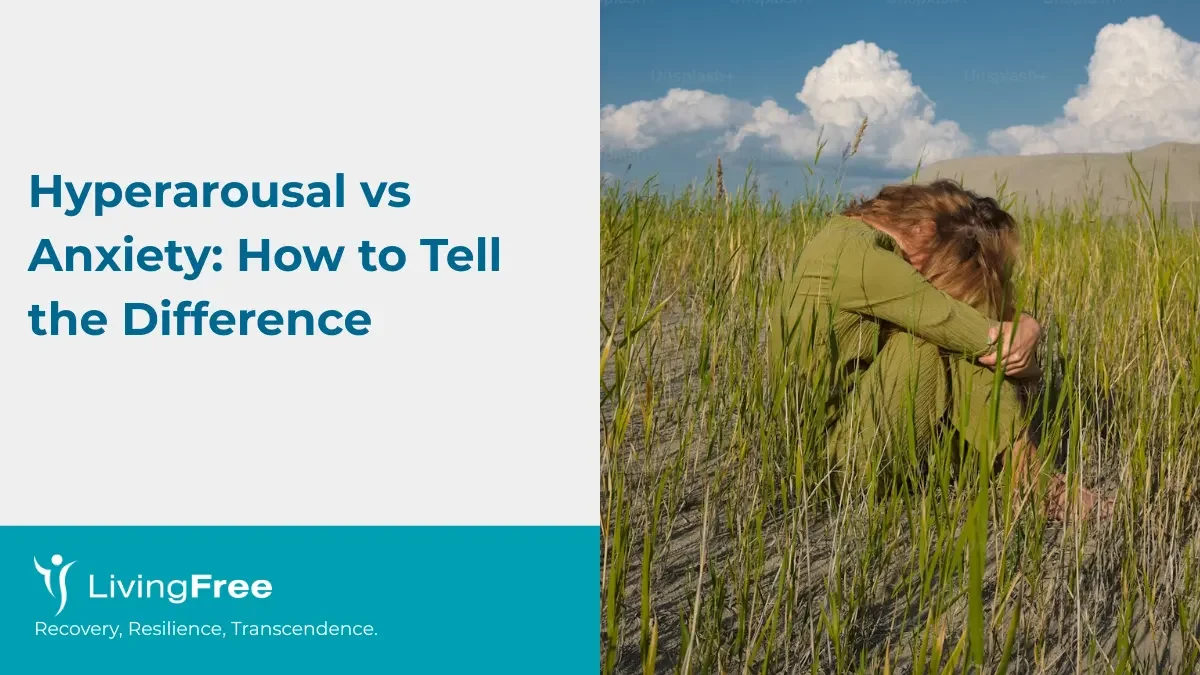Hyperarousal is a state of heightened anxiety and the body’s stress response being stuck in “on” mode, characterized by symptoms like hypervigilance, irritability, and difficulty sleeping. Anxiety is a broader feeling of dread and unease that can trigger hyperarousal, which is the intensified physical and emotional state that follows, often as a result of chronic stress or trauma. While anxiety is the feeling of unease, hyperarousal is the resulting physical state of being on high alert.
Hyperarousal and anxiety often feel similar. Both can make your body tense, your heart race, and your mind restless.
Yet they come from different processes in the brain and nervous system. Understanding how they differ helps you manage both more effectively.
What Is Hyperarousal
Hyperarousal is a physical state where the nervous system’s fight-flight-freeze response becomes stuck.
It often develops from trauma, PTSD, or chronic stress and can persist even when there is no danger. The body stays in survival mode, ready to react.
Hyperarousal Key Symptoms
- Hypervigilance: Constantly scanning for danger or being easily startled.
- Sleep disturbances: Trouble falling or staying asleep, frequent nightmares.
- Irritability and agitation: Feeling tense, jumpy, or quick to anger.
- Physical symptoms: Racing heart, tight muscles, sweating, and difficulty relaxing.
- Cognitive symptoms: Difficulty concentrating and intrusive thoughts.
Neurobiology
In hyperarousal, the prefrontal cortex loses some control over the amygdala, which manages fear and alarm.
The overactive amygdala keeps sending danger signals even when the person is safe. This imbalance keeps the body on alert and prevents true rest.
What Is Anxiety
Anxiety is a feeling of worry or unease about a future event or uncertain outcome.
It is a normal emotional response that becomes a problem when it is persistent or excessive.
Key Symptoms
- Psychological: Ongoing worry, dread, or fear about what might happen.
- Physical: Increased heart rate, shortness of breath, sweating, or dizziness.
- Behavioral: Avoiding situations that may cause discomfort or fear.
Relationship to Hyperarousal
Anxiety is emotional and mental. Hyperarousal is physical and neurological.
When anxiety is chronic, it can keep the body’s alarm system active, leading to hyperarousal. Anxiety sets off the stress response, and hyperarousal is what follows in the body.
Key Differences Between Hyperarousal and Anxiety
| Feature | Hyperarousal | Anxiety |
|---|---|---|
| Nature | A physical and neurological state of being on high alert. | An emotional and cognitive state of worry or fear. |
| Relationship | Can be seen as a prolonged or intense state of anxiety. | The feeling that can trigger the physical state of hyperarousal. |
| Duration | Often chronic, lasting after the threat is gone. | Can be brief or ongoing depending on thought patterns. |
| Cause | Commonly linked to trauma, chronic stress, or PTSD. | Triggered by uncertainty, daily stressors, or life changes. |
| Focus | Grounded in past or present danger. | Oriented toward future possibilities or imagined threats. |
| Treatment Focus | Body regulation and trauma processing. | Thought regulation and behavioral change. |
When Hyperarousal and Anxiety Overlap
Many people experience both together.
A trauma survivor may feel anxious before leaving home because it feels unsafe. The anxiety (mental worry) triggers hyperarousal (body tension).
Someone with anxiety might also experience hyperarousal during panic attacks when physical symptoms take over. Over time, this overlap creates exhaustion and sleep problems.
Is Hyperarousal the Same as Anxiety
Hyperarousal is one of the physical symptoms of anxiety, PTSD, and insomnia, but it is not the same as anxiety itself.
It reflects how the body reacts when the brain cannot turn off the stress response. Researchers describe hyperarousal through biological markers such as high cortisol, faster heart rate, and elevated brain activity.
Studies show that hyperarousal can persist during sleep, keeping the brain in a semi-alert state even at night. This explains why people with chronic stress often wake up feeling tired or restless.
What Does Hyperarousal Feel Like
Hyperarousal feels like being on edge all the time.
The senses become sharper, the heart beats faster, and breathing deepens as if preparing for danger. It feels like being in fight-or-flight mode even when nothing is wrong.
According to Verywell Mind, hyperarousal is “the body’s alarm system in overdrive,” where thoughts and emotions run faster than the body can calm down.
Understanding the Connection Between Anxiety and Hyperarousal
Both involve the same biological network between the amygdala, hypothalamus, and autonomic nervous system.
The mind detects potential danger and the body responds automatically. If that system never resets, anxiety becomes chronic and hyperarousal becomes the physical proof of that overactivity.
Healing must address both. Cognitive therapy helps calm the mind. Somatic and mindfulness techniques help calm the body.
Helpful Resources
- WebMD: Comparison of anxiety and insomnia symptoms.
- Verywell Mind: Understanding hyperarousal in PTSD.
- National Institutes of Health (NIH): Research on parental anxiety and infant hyperarousal.
- ScienceDirect: Studies on hyperarousal dynamics and brain activity during sleep.
Related Reading:
Are You Experiencing Hyperarousal?
What Causes Hyperarousal? Understanding the Body’s Alarm System


